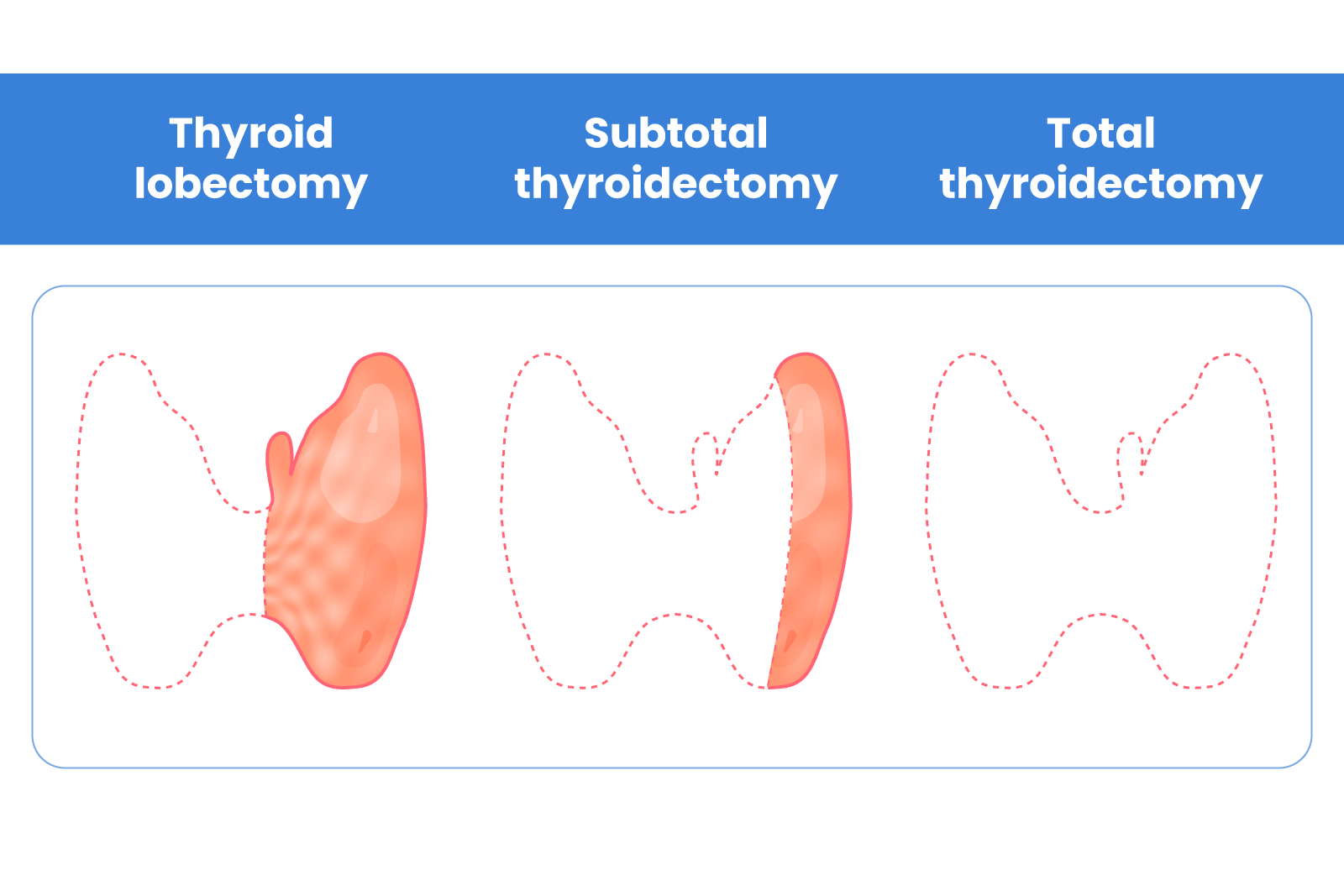Understanding the Different Types of Thyroidectomy
If you're dealing with thyroid cancer, understanding the different types of thyroidectomies can be an important part of your treatment. In this blog post, we'll take a look at the various types of thyroidectomies and how they can help you manage your condition.
What is a Thyroidectomy?
A thyroidectomy is a surgical procedure that involves the removal of all or part of the thyroid gland. The thyroid is a butterfly-shaped gland located in the front of the neck and is responsible for producing hormones that regulate your metabolism, heart rate, and other bodily functions. A thyroidectomy is typically performed to treat thyroid cancer, an overactive thyroid, or other conditions. Depending on the type of thyroid lesion, a total or partial thyroidectomy may be needed. In some cases, a radioactive iodine ablation may be combined with a thyroidectomy.
Why Might a Thyroidectomy be Necessary?
Thyroidectomies are typically recommended for people suffering from thyroid cancer, an enlarged thyroid (goiter), or certain types of thyroid nodules. In some cases, a thyroidectomy may also be necessary to treat Graves’ disease, a condition in which the body’s immune system attacks the thyroid gland.
If the thyroid is enlarged or there is a growth, the doctor will use imaging tests such as ultrasounds or CT scans to get a better look at the gland. They will also do blood tests to measure the amount of thyroid hormone in the body. Depending on the results of these tests, the doctor may recommend a thyroidectomy.
Types of Thyroidectomy
Thyroidectomy is the surgical removal of all or part of the thyroid gland. Depending on your condition, your doctor may recommend a total or near-total thyroidectomy, a partial thyroidectomy, or a hemi-thyroidectomy, also known as a lobectomy.
Total thyroidectomy is the surgical removal of all or most of the thyroid gland. This procedure is usually done to treat thyroid cancer, or to treat goiter, Graves’ disease, or hyperthyroidism when medications are not effective.
Subtotal thyroidectomy is the removal of part of the thyroid gland. This procedure is occasionally done to treat Graves’ disease to preserve a small amount functioning thyroid gland to avoid replacement therapy.
Lobectomy is the removal of one lobe (or half) of the thyroid gland. This procedure is usually done to treat benign thyroid conditions such as a nodule or goiter.
Thyroid lobectomy with isthmusectomy is the removal of a thyroid lobe along with the isthmus. This procedure is usually done to treat thyroid cancer or benign thyroid nodules.
Thyroidectomy with postoperative radioactive iodine ablation is the removal of the thyroid gland followed by a dose of radioactive iodine to kill any remaining thyroid cells. This procedure is used to treat some thyroid cancers.
Total Thyroidectomy
A total thyroidectomy is a surgical procedure that involves the removal of all or most of the thyroid gland. This procedure is used to treat thyroid cancers and other disorders of the thyroid. During a total thyroidectomy, the surgeon will make an incision in the neck and remove the entire thyroid gland, along with any lymph nodes that are affected. This procedure is typically done under general anesthesia and may take up to four hours. After the surgery, patients may require medication to replace the hormones produced by the thyroid. Patients should also be monitored for any potential complications, including infection, bleeding, and nerve damage.
Subtotal Thyroidectomy
A subtotal thyroidectomy is a type of thyroidectomy that removes a smaller portion of the gland than a total thyroidectomy. This procedure may be recommended when a patient has a smaller tumor that is localized in one area of the gland. During a subtotal thyroidectomy, the surgeon will remove only the affected area and the surrounding tissue, leaving some of the healthy tissue intact. This allows for some thyroid function to remain, reducing the risk of hypothyroidism. However, it is important to note that the remaining thyroid gland may still require further treatment to prevent recurrence.
Thyroid Lobectomy
A lobectomy is a type of thyroidectomy where only one lobe (or half) of the thyroid gland is removed. This type of surgery is sometimes referred to as a hemithyroidectomy. It is also possible to perform a partial thyroid lobectomy, where only a portion of the lobe is removed. This type of procedure is typically used to treat smaller tumors or nodules on the thyroid that are not necessarily cancerous. A lobectomy is less invasive than a total thyroidectomy and is associated with fewer risks and a faster recovery time.
Radioactive Iodine Ablation and Thyroidectomy
Radioactive iodine ablation is sometimes used in combination with thyroidectomy, depending on the type of thyroid cancer. In this treatment, radioactive iodine (RAI) is given to the patient orally. This radioactive material accumulates in the thyroid cells, destroying them. RAI ablation is usually done after a thyroidectomy to make sure any remaining cancer cells are destroyed. This combination treatment is effective in treating thyroid cancer, but it may increase the risk of complications, such as hypothyroidism. Therefore, it is important to discuss the potential risks and benefits of this treatment with your doctor.

Risks and Benefits of Thyroidectomy
Thyroidectomy is a major surgical procedure with inherent risks, including bleeding and infection. Other potential complications of thyroidectomy include damage to the vocal cords and parathyroid glands, which can lead to hoarseness or low calcium levels. It is important to discuss the risks and benefits of the procedure with your doctor beforehand.
In addition to the risks associated with any major surgery, there are several potential benefits to undergoing a thyroidectomy. Removing the thyroid can help alleviate the symptoms of hyperthyroidism, such as fatigue, weight gain, and difficulty sleeping. A thyroidectomy can also reduce the risk of developing thyroid cancer or other serious conditions. In some cases, a thyroidectomy can be the only treatment option for a thyroid disorder.
It is important to weigh the risks and benefits of a thyroidectomy before making any decisions about the procedure. Talk to your doctor about the potential risks and benefits of a thyroidectomy, as well as any other treatment options that may be available.
Preparing for a Thyroidectomy
Before undergoing a thyroidectomy, it’s important to talk to your doctor about what you can expect and what you need to do to prepare. Your doctor will likely order tests to determine the size and location of the thyroid, as well as any other medical conditions or medications that may affect the procedure. You may also need to stop taking certain medications prior to the procedure.
Additionally, you should plan for someone to drive you home after the procedure and arrange for help with activities of daily living, such as grocery shopping and housework, for the days following the surgery. Before the procedure, your doctor will ask you to fast for several hours. You should also let your doctor know about any allergies you may have and any medications you are taking.
It’s also important to be aware of the risks associated with a thyroidectomy. Your doctor will likely discuss these with you, but it’s important to ask questions and voice any concerns you may have prior to the procedure.
Recovery After a Thyroidectomy
Recovering from a thyroidectomy can be a long process, but it is important to follow your doctor's instructions to ensure a successful recovery. After the procedure, you may be asked to limit strenuous physical activity for a few weeks to allow your incision to heal properly. Your doctor may also prescribe medications to help manage pain and discomfort. Additionally, you may need to take thyroid hormone replacement for the rest of your life if your entire thyroid gland was removed.
You will likely need regular check-ups with your doctor to monitor your progress. During these visits, your doctor may order blood tests to check your thyroid hormone levels and other tests to check for any signs of complications.
It is also important to take care of yourself during the recovery process. Make sure to get plenty of rest and follow your doctor's instructions for taking medications and caring for your incision. Additionally, you may want to discuss any dietary or lifestyle changes you can make with your doctor to help improve your recovery.
Overall, a successful recovery from a thyroidectomy requires patience and dedication. As long as you follow your doctor's instructions and take care of yourself, you should be able to enjoy a full recovery.
Conclusion
Thyroidectomy is a major surgical procedure and should not be taken lightly. However, for many patients, thyroidectomy can provide a safe and effective way to treat thyroid disorders. If you think you need a thyroidectomy, it is important to discuss all of your options with a qualified physician. The risks and benefits of thyroidectomy should be carefully weighed and you should be sure to ask any questions that you may have. With the right preparation and medical care, a successful outcome is achievable.
Kentuckiana ENT, a Division of ENT Care Centers, has specialty thyroid surgeons with years of experience. If you need a thyroidectomy, contact our experts to have confidence that you are receiving the best thyroid care. Our qualified doctors use the latest techniques to treat thyroid nodules or thyroid cancers. Request an appointment with us today.













